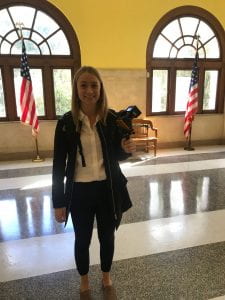1.14.20
Hours Worked:8am-5pm
Total Hours: 8
Tasks Completed:
First day orientation – setting up computer, email, downloading basic programs
Rendering Updates in Photoshop: Adding Donor Recognition to existing renderings in Photoshop. Editing the rendering to best show the recognition via street and building signage.
AXP Credit: Practice Management + Project Management
1.16.20
Hours Worked: 7am-7pm
Total Hours: 12
Tasks Completed:
Site Visit to Tomochichi Federal Courthouse in Savannah, Georgia
Brief Meeting with Judge
Site survey of LVL01 + LVL02 using 3D scanner (backpack).
Lunch with Liollio Team & Preservation Engineer, Craig Bennett who teaches at CDC.C
Images Allowed: Exterior + public space
AXP Credit: Construction & Evaluation
WEEKLY REFLECTION
This week I had the opportunity to work on two projects at very different phases. The first, Discovery Place – Nature, is a project finishing up schematic design. For this project I was asked to go into the Photoshop files for several renderings and add additional signage to recognize the main donor for the project. There were two different signage options (provided by the client) we had to show on about 6 different renderings. These renderings were used in a client meeting with the donor the following week. I was told that these renderings were made specifically for the donors interest and would hopefully provoke he/she to increase the donation. I was excited to perform this work because the original rendering were done in China and I wanted to look through their Photoshop file but unfortunately they had flattened and merged almost all layers. It was still very interesting to look through the hundreds of layers and see the overall composition.
The second project I worked on was the Tomochichi Federal Courthouse in Savannah, GA. I had the opportunity to join a team of two from Liollio who were going to the site to 3D scan. Within about six or seven hours we were able to scan two floors (the building’s footprint was a full city block). I was exposed to the 3D scanning process for the first time and was able to learn how to use the device and download the data on site from the device to a computer to be processed. This whole process was very interesting as we were scanning a fully occupied building. With each scan we performed we ran into obstacles such as private meetings taking place in rooms, court being in session in the multiple courtrooms, and even secure phone calls taking place in offices. These obstacles did add time to our visit but we were very fortunate for Becky Case, the Project Manager for US District Court of Southern Georgia who guided us around the building with ease. This experience taught me a lot about the 3D scanner including tips and tricks such as always walk through doorways backwards and aim for about 20 minute scans to not overload with data points.

